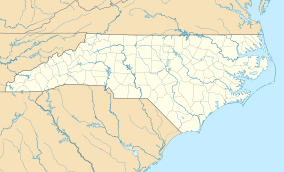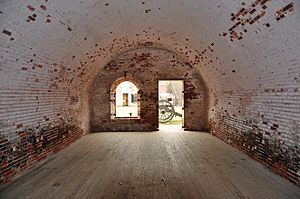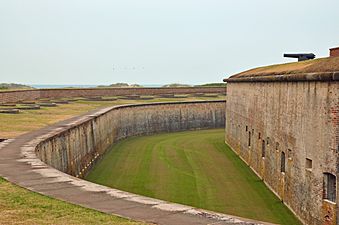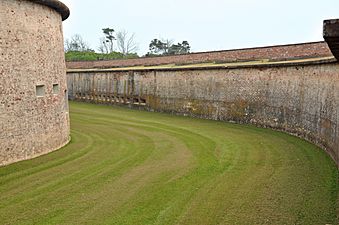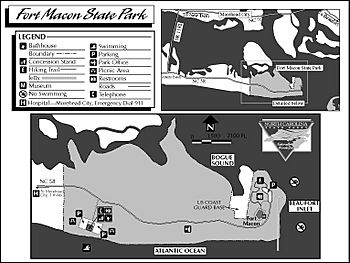Fort Macon State Park facts for kids
Quick facts for kids Fort Macon State Park |
|
|---|---|
|
IUCN Category IV (Habitat/Species Management Area)
|
|
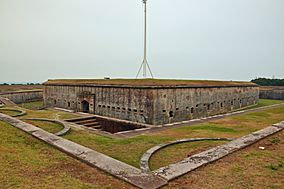
Fort Macon as viewed from one of the shoreward sides.
|
|
| Location | Carteret, North Carolina, United States |
| Area | 424 acres (172 ha) |
| Established | 1936 |
| Named for | Fort Macon |
| Governing body | North Carolina Division of Parks and Recreation |
| Website | Fort Macon State Park |
|
Fort Macon
|
|
| Nearest city | Atlantic Beach, North Carolina |
| Area | 9 acres (3.6 ha) |
| Built | 1826 |
| NRHP reference No. | 70000445 |
| Added to NRHP | February 26, 1970 |
Fort Macon State Park is a cool state park in Carteret County, North Carolina, United States. It's located on Bogue Banks near Atlantic Beach. The park first opened its doors in 1936.
Even though it's one of North Carolina's smallest state parks, covering about 424 acres, Fort Macon State Park is super popular! Around 1.3 million people visit it every year, making it the second most visited state park in North Carolina.
The main attraction is Fort Macon, a historic fort built to protect the coast. It was part of a big plan to defend the U.S. coastline. A famous battle, the Battle of Fort Macon, happened here in 1862 during the Civil War. Did you know Fort Macon is made of over 2.3 million bricks? That's more than any other U.S. fort!
Besides exploring the amazing restored fort, visitors can enjoy lots of fun activities. You can go fishing in the sound or the ocean, walk on nature trails, or join a ranger-guided tour to learn more about the park. There's also a safe swimming area, a snack stand, and a bathhouse. Most activities are free!
The park is open all year. You don't have to pay to get in or to park your car. During the colder months, the swimming area, snack stand, and bathhouse might be closed. But you can still swim at your own risk, and restrooms are open all year. The park also surrounds the United States Coast Guard Station Fort Macon. You might even see a Coast Guard Cutter (a type of boat) docked there!
Contents
Fort Macon's History
Fort Macon is a five-sided fort built from strong brick and stone. It has 26 vaulted rooms, called casements, inside its thick outer walls. These walls are about 4.5 feet thick!
Why Forts Were Needed
Today, we don't worry much about ships attacking the North Carolina coast. But in the 1700s and 1800s, the area around Beaufort was very open to attacks. Famous pirates like Blackbeard used to sail through Beaufort Inlet easily. Wars with Spain, France, and Great Britain also meant enemy warships could raid the coast. Beaufort was even captured by the Spanish in 1747 and the British in 1782.
North Carolina leaders knew they needed forts to stop these attacks. They decided the best spot for a fort was on the eastern tip of Bogue Banks, guarding the entrance to what is now Beaufort Inlet.
Early Forts and Coastal Defense
Construction of an early fort, Fort Dobbs, started in 1756. It was a small fort, but it was never fully finished. This left the inlet unprotected during the American Revolution. Later, in 1807, the U.S. government started building a chain of coastal forts. This was called the "Second System" of fortifications.
Work began on Fort Hampton, a small fort made of masonry. It had a horseshoe shape facing the water. Its walls were very thick, and it had five 18-pounder cannons. These cannons could fire an 18-pound iron ball almost a mile! The fort also had a two-story barracks for soldiers and a small building for gunpowder.
During the War of 1812, soldiers left Fort Hampton for other duties. But North Carolina leaders quickly sent local militia (citizen soldiers) to protect the fort. Even though no major attack happened, the fort was important for defense. Over time, the ocean's tides started to erode the land where Fort Hampton stood. By 1834, the fort was actually underwater!
Building Fort Macon
The War of 1812 showed that America's coastal defenses needed to be much stronger. So, the U.S. government started building a new, improved chain of forts. This was called the "Third System" of fortifications. Fort Macon was a key part of this plan. Its main job was to protect Beaufort Inlet and Beaufort Harbor, which was North Carolina's only major deepwater port.
The fort was named after Nathaniel Macon, a U.S. Senator from North Carolina. He helped get the money to build it. Construction began in 1826 and took eight years to finish, opening in December 1834. It cost about $463,790 to build. In the 1840s, Robert E. Lee, who later became a famous general in the Confederate Army, even helped design a system to stop erosion at the fort.
Fort Macon During the Civil War
When the Civil War began on April 12, 1861, local North Carolina militia quickly took control of Fort Macon for the state and the Confederacy. Confederate forces held the fort for a year, getting it ready for battle and adding 54 heavy cannons.
In early 1862, Union forces, led by Maj. Gen. Ambrose E. Burnside, moved through eastern North Carolina. Part of his army, led by Brig. Gen. John G. Parke, was sent to capture Fort Macon. Parke's soldiers took Morehead City and Beaufort easily. Then, in March and April, they landed on Bogue Banks to attack Fort Macon.
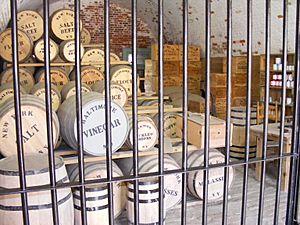
The Confederate commander inside the fort, Col. Moses J. White, and his 400 soldiers refused to give up, even though they were surrounded. On April 25, 1862, Union forces bombarded the fort for 11 hours. They used powerful siege guns on land and had help from four Union gunboats in the ocean and floating batteries in the sound.
The fort easily fought off the gunboat attack. However, the Union land batteries used new, powerful rifled cannons. These cannons hit the fort 560 times, causing a lot of damage. Because of this damage, Col. White had to surrender the next morning, April 26. The Confederate soldiers were taken as prisoners of war. This battle was one of the first times new rifled cannons were used against a fort. It showed that old-style forts might not be strong enough anymore. The Union kept Fort Macon for the rest of the war, and Beaufort Harbor became an important place for their navy ships to get coal and repairs.
After the Civil War
After the Civil War, during the Reconstruction Era, the U.S. Army used Fort Macon until 1877. For about 11 years, it was even used as a prison because there weren't many other prisons in North and South Carolina. After 1877, the fort was mostly empty. It was briefly used again by state troops in 1898 during the Spanish–American War. Finally, in 1903, the U.S. Army completely left the fort.
In 1923, Fort Macon was put up for sale as extra military property. But North Carolina leaders wanted to save it. So, in 1924, a special law allowed the fort and the land around it to be sold to the state of North Carolina for just $1! The state wanted to use it as a public park. This was only the second area the state got for its new state park system.
From 1934 to 1935, a group called the Civilian Conservation Corps (CCC) helped restore the fort and build public recreation areas. This allowed Fort Macon State Park to officially open on May 1, 1936. It became North Carolina's first working state park!
During World War II, the U.S. Army leased the park again from the state. Soldiers were stationed at the old fort from 1941 to 1944 to protect important nearby places. During this time, a strange accident happened. Some soldiers rolled old cannonballs into a fireplace, thinking they were just solid iron. But these cannonballs were still filled with gunpowder! They exploded, sadly killing two men and injuring others. People sometimes call this the "last shot of the Civil War." On October 1, 1946, the Army gave the fort and park back to the state.
You can learn even more about Fort Macon in the book Fort Macon: A History by Paul R. Branch Jr. He's been a Park Ranger and historian at Fort Macon for over 20 years!
Gallery
Nearby Parks
Here are some other state parks not too far from Fort Macon State Park:
- Hammocks Beach State Park in Onslow County
- Theodore Roosevelt State Natural Area in Carteret County (this park is managed by Fort Macon State Park!)
Park Hours
- Park hours:
- November–February: 8 a.m. − 6 p.m.
- March, October: 8 a.m. − 7 p.m.
- April, May, September: 8 a.m. − 8 p.m.
- June–August: 8 a.m. − 9 p.m.
- Swimming Area: 10 a.m. − 5:45 p.m.
- Fort: 9 a.m. − 5:30 p.m.
- Closed Christmas Day
- Park office hours:
- 8 a.m. − 5 p.m. daily
- Closed state holidays


